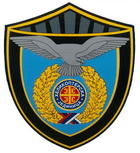Serbian police helicopter unit
| Helicopter unit of Serbian Ministry of Internal Affairs | |
|---|---|
 Unit emblem | |
| Agency overview | |
| Formed | 1964 |
| Jurisdictional structure | |
| Operations jurisdiction | Serbia |
| Headquarters | Belgrade Nikola Tesla Airport |
|
| |
| Parent agency | Serbian Ministry of Internal Affairs |
| Facilities | |
| Helicopters | 22 |
The Helicopter unit (Serbian Cyrillic: Хеликоптерска јединица) is an air support unit of the Serbian Police. Its purpose it to provide aerial surveillance, border monitoring, VIP transport, medevac, search and rescue, and aerial firefighting.[1]
History
The Yugoslav Milicija (Serbia's host country before 2006) acquired its first helicopter, an Bell 47 J-2, in 1965. Operations were shared with the Belgrade City Police. Subsequently, a number of regional Police helicopter units were created throughout SR Serbia. In the 1970s and 1980s federal, republic and autonomous provinces governments have acquired a number of helicopters.
At the end of the 1980s, due the centralization of all police force in Serbia, all police helicopters, from autonomous provinces, republic and city police helicopter units were brought under central control Public Security Services (Resor Javne Bezbednosti – RJB), under the Ministry of Internal Affairs.
When riots broke out in Kosovo and Metochia in 1989 and 1990, helicopters were used to break up the mass demonstrations by Albanians. AB212 were used to transport special forces units to rebel strongholds.
The highly secretive Serbian Security Services (Serbian Latin: Resor Državne Bezbednosti – RDB) was formed in 1992, under the Ministry of Internal Affairs. It started with a small helicopter section with one Bell 206B-3 and one 206L-1. The helicopter section expanded by taking over AB212 and Gazelle helicopters from disbanded Federal Police units.
The RDB took part in combat operations in Bosnia and Herzegovina and Croatia in support of ethnic Serb forces – often flying without any markings or only marked with the Serbian flag. In 1997 RDB combat units were reorganised into a Brigade level unit: the Unit for Special Forces (JSO), including the helicopter squadron. The JSO took part in numerous combat operations during the escalating Kosovo and Metochia crisis. Mi-24s were used to attack rebel training camps and hundreds of transport and medevac flight were carried out. During NATO Operation Allied Force JSO helicopters continued to fly liaison and medivac missions. No helicopters were lost.
In October 2001 the helicopters were publicly presented for the first time, during a joint exercise with Federal military forces. Serbia's Interior Ministry (MUP) was reorganised in 2002, with the JSO being detached from the national security service and placed directly under the Interior Minister. The helicopters were combined with the police squadron to form a joint helicopter unit as it is now. The JSO itself was officially disbanded on 25 March 2003, following the assassination of the Prime Minister Zoran Đinđić by the JSO's deputy commander on 12 March.
Helicopters
Current fleet
| Aircraft | Origin | Versions | Number | Notes |
|---|---|---|---|---|
| Bell 206 | 206B | 4 | ||
| Bell 212 | AB 212 | 3 | ||
| Soko Gazelle | SA 341G / SA 342L | 4 | 2 stored | |
| Sikorsky S-76 | S-76B | 1 | ||
| Eurocopter EC145 | H145M | 3 on order[2][3] | ||
Retired fleet
| Aircraft | Origin | Versions | Number | Notes |
|---|---|---|---|---|
| Bell 47J Ranger | Bell 47J-2A | ? | ||
| Agusta-Bell 206 | 206A 206B |
3 1 |
||
| Aerospatiale AS365 | SA 365N | 2 | Sold in 2004,One sold to Togo,second to Germany (private company). | |
| Mi-17 | Mi-17 | 2 | Used by JSO, transferred to air force | |
| Mi-24 | Mi-24V | 2 | Used by JSO, retired |
See also
References
- ↑ Хеликоптерска јединица Archived 2010-11-22 at the Wayback Machine. (In Serbian)
- ↑ "Republic of Serbia Orders Nine H145M". Airbus. 28 December 2016. Retrieved 7 October 2018.
- ↑ Bozinovski, Igor (4 January 2017). "Serbia buys nine H145M helicopters from Airbus". janes.com. IHS Jane's Defence Weekly. Archived from the original on 21 June 2017.